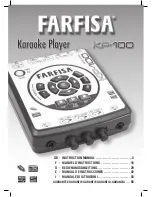
s
DANGER!
Ensure machine is disconnected from power supply before performing service or maintenance on any part of the unit, cables or torch.
7.1.
The power unit.
DO NOT open the machine. Service and maintenance of the machine must only be undertaken by an authorised service agent.
7.1.1. Keep the machine clean by wiping with a soft cloth. Do not use abrasives.
7.1.2. Periodically check to ensure the carrying handle is in good order and condition. If not replace it immediately.
7.1.3. Ensure that the front and rear air vents are not blocked.
7.2.
Cables, and leads.
7.2.1. Check to ensure cables and leads are in good order and condition. If damaged contact your authorised service agent.
7.2.2. Keep cables and leads clean. Do not use solvents.
7.3.
Torch.
Check torch regularly. Maintenance will depend on frequency and type of usage and is essential for correct
and safe use of torch.
p
WARNING! Ensure the torch is cool before attempting any maintenance. Always re-assemble the torch
in the correct order ensuring that electrode, distributing ring and nozzle, before the nozzle holder.
Never use tools to tighten nozzle components, hand tighten only.
Manually dismantle the torch nozzle head (fig 7).
Items 3A and 5A are optional extension nozzles.
7.3.1. Nozzle holder. (fig 7 item 2).
Clean nozzle holder and check to ensure it is not damaged, (including distortion, burns, or cracks) if in any
doubt replace the item.
7.3.2. Nozzle. (fig 7 item 3 & 3A).
If surface is oxidised clean it with extra fine abrasive paper. Check wear of the plasma arc
hole and the inner and outer surfaces. If hole has widened, or nozzle is damaged in any way
replace it immediately. The nozzle V crater should be 2mm in depth (fig 8).
7.3.3. Air Distributing Ring (fig 7 item 4).
Check that the ring is not burned or cracked and that the airflow holes are not obstructed. If damaged
replace immediately.
7.3.4. Electrode. (fig 7 item 5 & 5A).
Check the build up on the emitting surface of the electrode. When the build up is approximately 2mm
replace the electrode.
NOTE:
We recommend that the electrode and nozzle should be changed at the same time.
7.3.5. Spacer. (fig 7 item 1, & fig 9).
The spacer (fig 9) must be replaced if distorted or coated by scoria and is impossible to keep the torch
in the correct position.
7.4.
Compressed Air filter.
The filter (fig 1) drains condensation from the air system, and must be keep clean.
7.4.1. Regularly Inspect the filter. If the glass bowl contains water, drain by pushing the drain plug upwards.
7.4.2. When the filter cartridge becomes dirty replace immediately.
7.4.3. Clean the filter with clean soapy water only. Do not use abrasives, or solvents.
7. MAINTENANCE
p
WARNING!
before operating the machine ensure that you have read, understand and apply chapter 2 safety instruction, and that you have
familiarised yourself with the controls. Ensure the machine is disconnected from the power supply before moving or changing accessories.
6.1.
Set up
6.1.1. Ensure you have the compressed air connected correctly to the machine. (see chapter 4).
6.1.2. Check that the Earth cable is correctly clamped to the piece to be cut as (see chapter 5).
6.1.3. Switch on the mains power supply and the machine on switch (turn switch in fig 3.1. to the I position).
6.1.4. Set the regulator switch the the appropriate position for the task to be performed (fig 4).
6.1.5. Press the torch button to commence the flow of cooling air (post-air).
6.1.6. Check the torch technical data and set the air pressure until the air gauge (fig 2. 4) indicates the correct value.
6.1.7. Allow the air flow to continue until any condensation has been removed from the torch. At this point the
air flow should automatically stop.
6.2.
Cutting workpiece beginning from the edge.
The torch provided with this unit can actually make contact with the material to be cut (touch-cut).
For cutting light materials however, a spacer (fig 9), has been provided, which prolongs the life of the
electrode and nozzle.
NOTE:
If the unit is being used over 30Amps, the spacer
MUST
be removed.
6.2.1. Bring the torch nozzle toward the edge of workpiece and hold it at 3mm above the cutting line.
6.2.2. Press the torch button on. Pre-air will generate immediately igniting the pilot arc (after about 2 seconds).
If the distance between the torch nozzle and the workpiece is correct, the arc will jump to the cutting line thereby
commencing the cutting process.
6.2.3. Move torch slowly and smoothly forward along the cutting line at a consistent height from workpiece.
6.2.4. Adjust cutting speed according to the thickness of the material to be cut, and the selected current.
6.2.5. Check the underside of material being cut. The arc (flame) should have a 5 - 10
O
tilt (fig 5).
6.3.
Cutting workpiece by piercing item.
6.3.1. Place torch nozzle at the maximum bracket angle to the position you wish to commence cutting (fig 6).
6.3.2. Ignite the torch arc, then slowly and smoothly bring the arc to the upright position.
6.4.
To stop the arc.
6.4.1. Release torch button to stop the arc. The post-air will continue to flow cooling the nozzle.
6.4.2. Other reasons why the arc will stop operating are:
a) If the distance between the torch nozzle and workpiece is too great.
b) If you have completed a cut and have continued beyond the edge of a workpiece.
c) The waste cut off falls away from the workpiece thus increasing the gap.
6. OPERATING INSTRUCTIONS
fig 5.
fig 6.
fig 7.
fig 8.
fig 9.
MW100, MW140, MW165 - 0051 - (1) - 010399























